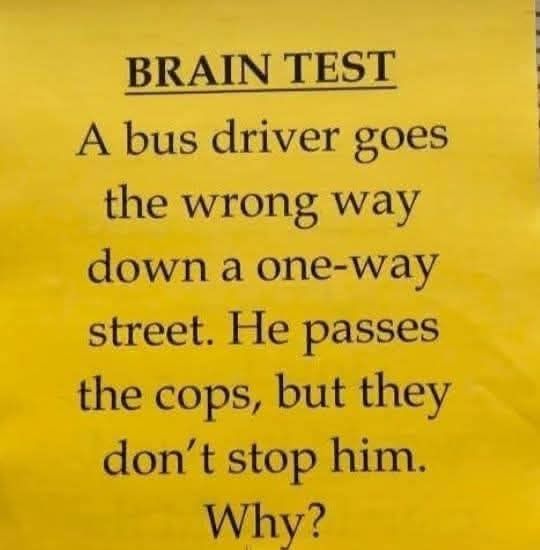Brain teasers are like mental workouts – they challenge our thinking, twist our logic, and often leave us scratching our heads. One riddle that has puzzled many is the classic scenario involving a bus driver who seemingly breaks the law without facing any consequences. It’s a story that catches you off guard because the answer is so simple that most people completely overlook it.
Ready to stretch your mind? Let’s dive into the brain teaser of the bus driver and the one-way street and unravel why it leaves so many people stumped.
The Riddle Recap: What’s Going On?
Here’s how the riddle goes:
“A bus driver goes the wrong way down a one-way street. He passes the cops, but they don’t stop him. Why?”

At first glance, this situation sounds like a blatant violation of traffic rules. Naturally, most people imagine the bus driver behind the wheel of a bus, heading against traffic. After all, that’s what bus drivers do, right? They drive. And going the wrong way down a one-way street? That’s a surefire ticket, or worse.
But wait – the riddle never actually says that the bus driver is driving a bus. That’s where most of us fall into the trap. We’re so conditioned to picture a bus driver in their professional setting that we completely miss the real point.
Unpacking the Trick: A Matter of Perspective
The key to solving this riddle is to carefully consider the wording. The riddle states that the bus driver “goes” the wrong way – not “drives.” This subtle distinction is what makes the riddle so clever and deceptive.
Now, think about it. The bus driver could be going the wrong way down the street without actually being in a vehicle. How? The answer is simple: the bus driver is walking.
Walking down a one-way street in the opposite direction is perfectly legal for pedestrians. When the bus driver walks past the cops, they don’t stop him because there’s absolutely nothing illegal about walking the wrong way on a one-way street.
Video: 🧩Riddle Me This? A bus driver goes the wrong way down a one-way street.
Why We Get Tricked: The Power of Assumptions
This riddle works so well because it takes advantage of our natural tendency to make assumptions based on context. Here are a few reasons why it’s so effective:
- Contextual Bias:
When we hear the words “bus driver,” our brains immediately conjure up an image of someone behind the wheel. It’s almost automatic. Our minds rarely entertain the idea that a bus driver could be doing anything else, like walking. - Overcomplicating Simple Situations:
We’re wired to think that a riddle must be complicated or have a trick answer. In reality, the answer is often straightforward, but our tendency to overthink gets in the way. - Language Ambiguity:
The riddle cleverly uses ambiguous wording to mislead us. It never actually says that the bus driver is driving, but our minds fill in that gap because of the context provided.

The Psychology Behind the Riddle: Why We Fall for It
This brain teaser isn’t just a fun mental puzzle – it’s also a fascinating glimpse into how our brains process information. Here’s why it’s so tricky:
- Cognitive Bias:
Our brains rely on context and past experiences to make quick judgments. Since bus drivers usually drive buses, we immediately latch onto that idea without questioning it. - Mental Shortcuts:
We often use mental shortcuts (heuristics) to make sense of information quickly. In this case, the shortcut leads us to associate “bus driver” with “driving,” even though the riddle never specifies that. - Expectation vs. Reality:
Riddles often play on our expectations. We expect a riddle to be clever or complex, so our minds go searching for hidden meanings rather than considering the obvious.
What This Riddle Teaches Us: Think Outside the Box
If this riddle leaves you feeling a bit baffled, don’t worry – you’re not alone. The lesson here is that we often get so caught up in what we think should be true that we forget to question our assumptions.
When solving problems or puzzles, it’s crucial to take a step back and consider alternative perspectives. Sometimes the most straightforward answer is the correct one, even if it seems too simple to be right.
Think about how often this principle applies in real life. How many times have you jumped to a conclusion without questioning your assumptions? Whether in problem-solving, conversations, or decision-making, taking a moment to reassess the situation can make all the difference.
Video: The Riddle Challenge: Solve the Mystery! 🤔 | Riddles and Answer #riddles
Applying the Lesson: Rethink Your Approach
This riddle is more than just a fun challenge – it’s a reminder to question the obvious. Instead of jumping to conclusions based on preconceived notions, try looking at situations from different angles.
In everyday life, we’re often presented with problems that seem complicated at first glance. By breaking down the information and challenging our assumptions, we might find that the answer is simpler than we thought.
Next time you encounter a problem that seems too complex, remember the bus driver and the one-way street. Instead of immediately accepting the most obvious interpretation, ask yourself, “Am I making any assumptions here?” You might just surprise yourself with the answer.
Conclusion: A Simple Yet Brilliant Riddle
The bus driver and the one-way street riddle is a perfect example of how our brains can trick us into overthinking. It’s not about being smarter or quicker – it’s about approaching problems with an open mind and a willingness to question the obvious.
By learning to think beyond assumptions, we can tackle challenges more creatively and effectively. So, next time you hear a brain teaser or face a complex problem, take a moment to rethink your initial reaction. Sometimes, the simplest explanation is the one you overlooked.
In the end, the real trick isn’t just solving the riddle – it’s learning how to think differently.